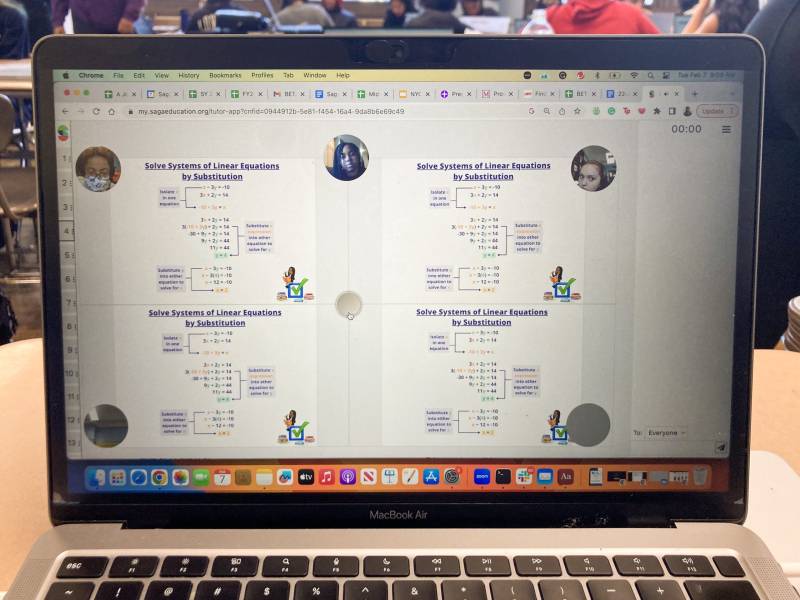However, online tutoring can be effective when students participate regularly. In this Northern California study, reading achievement increased substantially, in line with in-person tutoring, for the roughly 200 students who got at least 20 sessions across 10 weeks.
The students who logged in regularly might have been more motivated students in the first place, the researchers warned, indicating that it could be hard to reproduce such large academic benefits for all. During the periods when children were supposed to receive tutoring, researchers observed that some children – often ones who were slightly higher achieving – regularly logged on as scheduled while others didn’t. The difference in student behavior and what the students were doing instead wasn’t explained. Students also seemed to log in more frequently when certain staff members were overseeing the tutoring and less frequently with others.
Small group tutoring doesn’t work as well online
The large math and reading gains that researchers documented in small groups of students with in-person tutors aren’t always translating to the virtual world.
Another study of more than 2,000 elementary school children in Texas tested the difference between one-to-one and two-to-one online tutoring during the 2022-23 school year. These were young, low-income children, in kindergarten through 2nd grade, who were just learning to read. Children who were randomly assigned to get one-to-one tutoring four times a week posted small gains on one test, but not on another, compared to students in a comparison group who didn’t get tutoring. First graders assigned to one-to-one tutoring gained the equivalent of 30 additional days of school. By contrast, children who had been tutored in pairs were statistically no different in reading than the comparison group of untutored children. A draft paper about this study, led by researchers from Stanford University, was posted to the Annenberg website in May 2024.
Another small study in Grand Forks, North Dakota confirmed the downside of larger groups with online tutoring. Researchers from Brown University directly compared the math progress of middle school students when they received one-to-one tutoring versus small groups of three students. The study was too small, only 180 students, to get statistically strong results, but the half that were randomly assigned to receive individual tutoring appeared to gain eight extra percentile points, compared to the students who were assigned to small group tutoring. It was possible that students in the small groups learned a third as much math, the researchers estimated, but these students might have learned much less. A draft of this paper was posted to the Annenberg website in June 2024.
In surveys, tutors said it was hard to keep all three kids engaged online at once. Students were more frequently distracted and off-task, they said. Shy students were less likely to speak up and participate. With one student at a time, tutors said they could move at a faster pace and students “weren’t afraid to ask questions” or “afraid of being wrong.” (On the plus side, tutors said groups of three allowed them to organize group activities or encourage a student to help a peer.)
Behavior problems happen in person, too. However, when I have observed in-person small group tutoring in schools, each student is often working independently with the tutor, almost like three simultaneous sessions of one-to-one help. In-person tutors can encourage a student to keep practicing through a silent glance, a smile or hand signal even as they are explaining something to another student. Online, each child’s work and mistakes are publicly exposed on the screen to the whole group. Private asides aren’t as easy; some platforms allow the tutor to text a child privately in a chat window, but that takes time. Tutors have told me that many teens don’t like seeing their face on screen, but turning the camera off makes it harder for them to sense if a student is following along or confused.
Matt Kraft, one of the Brown researchers on the Grand Forks study, suggests that bigger changes need to be made to online tutoring lessons in order to expand from one-to-one to small group tutoring, and he notes that school staff are needed in the classroom to keep students on-task.
School leaders have until March 2026 to spend the remainder of their $190 billion in pandemic recovery funds, but contracts with tutoring vendors must be signed by September 2024. Both options — in person and virtual — involve tradeoffs. New research evidence is showing that virtual tutoring can work well, especially when motivated students want the tutoring and log in regularly. But many of the students who are significantly behind grade level and in need of extra help may not be so motivated. Keeping the online tutoring small, ideally one-to-one, improves the chances that it will be effective. But that means serving many fewer students, leaving millions of children behind. It’s a tough choice.


